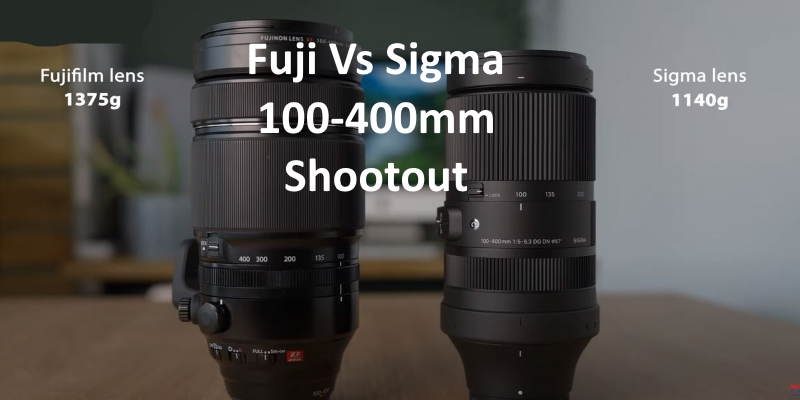
Fuji 100-400mm vs Sigma 100-400mm f/5-6.3 DG DN OS Contemporary Lens Test And Reviews.
When it comes to telephoto zoom lenses, the 100-400mm focal range is a popular choice for many photographers, especially those shooting wildlife, sports, or distant subjects. Two notable contenders in this category are the Fujinon XF 100-400mm f/4.5-5.6 R LM OIS WR and the Sigma 100-400mm f/5-6.3 DG DN OS Contemporary lens. Both have their unique features and strengths, but how do they stack up against each other? Let’s dive into a comprehensive comparison.
1. Build and Design
Fuji 100-400mm:
This lens, designed specifically for Fujifilm’s X-series mirrorless cameras, boasts a robust build. It’s weather-sealed, making it dust and moisture-resistant, which is crucial for outdoor photographers. The lens is built with 21 elements in 14 groups, including five ED elements and one Super ED element.
Sigma 100-400mm f/5-6.3 DG DN OS Contemporary:
Sigma’s offering is a part of their Contemporary line, aiming to provide high performance with a compact design. The lens is constructed with 22 elements in 16 groups and features a brass bayonet mount. It’s not as comprehensively weather-sealed as the Fuji but still offers a good degree of protection.
2. Image Quality
Fuji 100-400mm:
One of the lens’s key selling points is its optical performance. The combination of ED and Super ED elements ensures minimal chromatic aberration and delivers sharp, clear images. The lens also performs exceptionally well in terms of color rendition and contrast.
Sigma 100-400mm f/5-6.3 DG DN OS Contemporary:
Sigma lenses, especially in their Art and Contemporary line, are known for producing sharp images. This lens is no exception. It offers impressive sharpness, especially in the center, even at wider apertures. There might be a slight softness at the edges, but it’s often negligible.
You can find the Fuji 100-400mm here. And the Sigma 100-400mm Here.
3. Autofocus
Fuji 100-400mm:
This lens comes equipped with a twin linear motor for quick and quiet autofocus. It’s particularly efficient when tracking moving subjects, making it a top choice for wildlife and sports photographers.
Sigma 100-400mm f/5-6.3 DG DN OS Contemporary:
Sigma uses a stepping motor, which is silent and suitable for both photos and video. While it’s quick in good light, in lower light situations, the autofocus might struggle a bit more than the Fuji.
4. Image Stabilization
Fuji 100-400mm:
Fujifilm integrated a 5-stop image stabilization system in this lens. It’s a boon for handheld shooting, especially at the telephoto end where camera shake can be more pronounced.
Sigma 100-400mm f/5-6.3 DG DN OS Contemporary:
Sigma’s Optical Stabilizer (OS) system is effective and helpful for handheld shots. However, it might not be as efficient as Fuji’s 5-stop system, especially in challenging conditions.
5. Compatibility and Usability
Fuji 100-400mm:
Being designed specifically for the Fujifilm X-series, this lens offers seamless compatibility with Fuji mirrorless cameras. The lens also has a tripod collar, which is handy for long-duration shooting.
Sigma 100-400mm f/5-6.3 DG DN OS Contemporary:
The “DG DN” in its name indicates it’s designed for mirrorless cameras. Depending on the mount (Sony E-mount or Leica L-mount), its usability will vary. One downside is the lack of a tripod collar, which can be limiting for some users.
6. Price Point
Price is always a significant factor in any purchasing decision. The Sigma 100-400mm tends to be more budget-friendly compared to the Fuji 100-400mm. However, it’s essential to consider the entire ecosystem, including camera bodies and other accessories, when looking at the overall cost.
Rap-Up:
Choosing between the Fuji 100-400mm and the Sigma 100-400mm f/5-6.3 DG DN OS Contemporary depends on your needs, brand loyalty, and budget.
If you’re a Fujifilm user and prioritize robust weather sealing, superior image stabilization, and a tripod collar, the Fuji 100-400mm might be the lens for you. On the other hand, if you’re looking for a more budget-friendly option that still delivers in terms of image quality and is suitable for Sony E or Leica L mounts, the Sigma 100-400mm would be a commendable choice.
Both lenses are excellent in their own right, and neither would disappoint in their performance. Ultimately, the right lens is the one that aligns best with your photography needs and preferences.
Sigma 100-400mm Specs
FOCAL LENGTH & ANGLE OF VIEW: 100-400mm (24.4° to 6.2°)
LENS MOUNT(S): Sony E, Leica L, Fuji X.
APERTURE & RANGE: f/5-6.3 to f/22-29
STABILIZATION: Yes, Sigma OS (Does not work in conjunction with in-body stabilization)
AUTOFOCUS: Yes, near-silent stepper motor
MANUAL FOCUS: Yes, electronically controlled, no focus/hyperfocal markings (only on digital display)
OPTICAL CONSTRUCTION: 22 elements in 16 groups, one “F” Low Dispersion, four Special Low Dispersion elements
MECHANICAL CONSTRUCTION: Metal, no weather sealing (besides mount gasket)
MAGNIFICATION & MINIMUM FOCUS DISTANCE: 0.24x, 3.6 ft (1.1m)
FILTER THREADS & HOOD: 67mm filter threads, reversible bayonet hood
Tripod Collar: Not included, optional accessory (Sigma TS-111, $130)
SIZE: 3.39 x 7.76 in. (86 x 197.2 mm)
WEIGHT: 2.5 lb (1135 g)
Fujinon XF 100-400mm f/4.5-5.6 R LM OIS WR Specs
Mount: X-mount
Format coverage: APS-C
35mm format equivalent: 152-609mm
Angle of view: 16.2° – 4.1°
Weather sealing: Yes
Maximum aperture: 4.5 (W) – 5.6 (T)
Minimum aperture: 22
Number of aperture blades: 9
Closest focusing distance: 1.75m
Maximum image magnification: 0.19x
Lens configuration: 21 elements / 14 groups
Special elements: 1 Super ED, 5 ED elements
Lens surface coating: Yes
Optical stabilisation: Yes (5 stops)
Dimensions: ø94.8mm x 210.5mm (270mm when extended)
Filter diameter: ø77mm
Weight: 1375g
Thanks to Wilkinson Camera for the great review.